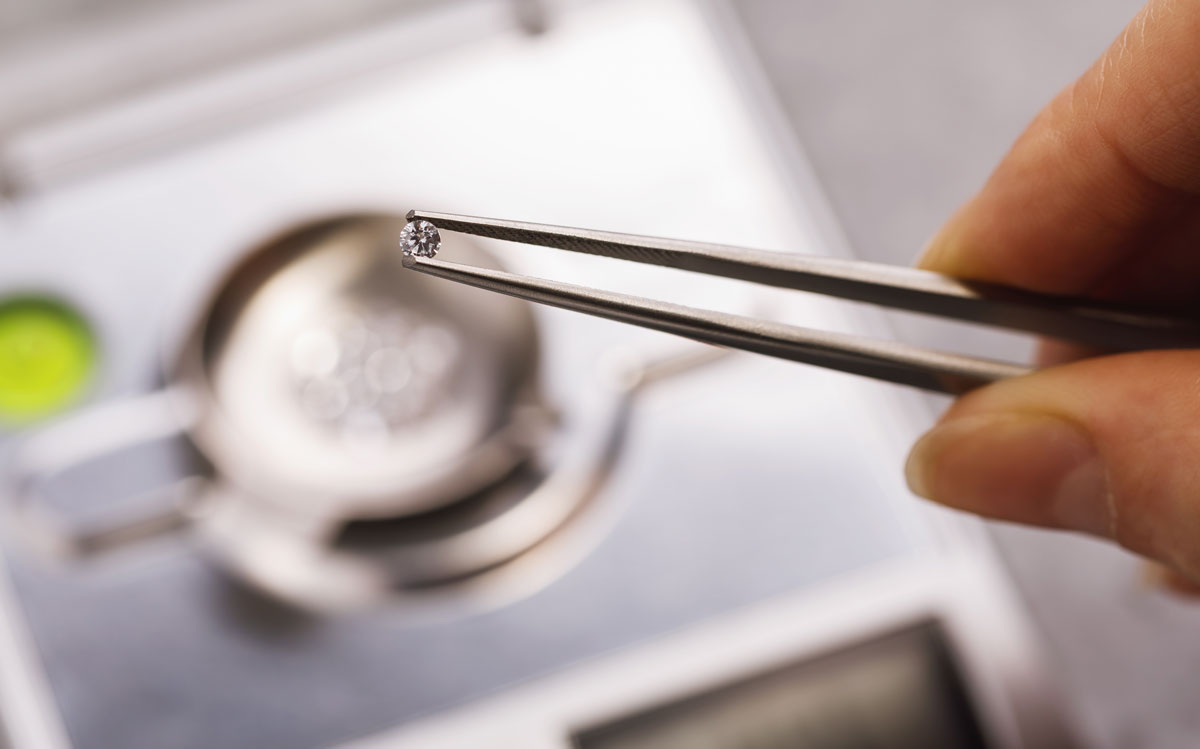Ever wondered why two diamonds of the same carat weight can appear different in size?
Or why a 0.99-carat diamond might be a smarter purchase than a 1.00-carat one?
In this comprehensive guide, we’ll demystify the concept of carat weight and provide you with a deep understanding of its role in determining a diamond’s appearance and price.
We’ll explain how carat weight interacts with cut quality, shape and colour, and reveal insider tips on choosing the perfect carat weight for your engagement ring without compromising on its brilliance.
Ready to become a carat connoisseur? Let’s dive in!
What Is Diamond Carat?
Diamond carat refers to the weight of a diamond, not its size, as many people think.
Understanding this is absolutely key as two diamonds that have the same carat weight can look very different sizes.
Larger diamonds are rarer and generally more valuable than smaller ones. However, carat alone does not determine a diamond’s overall quality; factors such as cut, colour, and clarity also play crucial roles in its appearance and desirability.

A Brief History of the GIA Diamond Grading System
The Gemological Institute of America (GIA) has played a pivotal role in shaping the modern diamond industry.
Before the introduction of the 4Cs, diamond grading and measurement was often subjective and varied widely between different appraisers and regions.
In 1953, the GIA introduced the ‘4Cs’ system, a revolutionary approach that standardised the way diamonds were graded. The 4Cs stand for carat, cut, colour, and clarity, with carat being the weight of the diamond.
This system provided a uniform method to evaluate and compare diamonds, allowing for more transparent and consistent pricing. It transformed the diamond industry by replacing vague and inconsistent grading methods with clear and universally accepted standards.
The introduction of carat as one of the 4Cs emphasised the importance of weight in determining a diamond’s value.
Understanding Diamond Carat Weight
Diamond carat weight is a fundamental aspect that every diamond buyer should understand. It’s not just a number but a reflection of the diamond’s size, value, and rarity.
Let’s explore how carat weight is measured and how it relates to a diamond’s visual size.
How Carat Weight is Measured
Carat weight is the standard unit of measurement for diamonds and other precious gemstones. It’s a precise and universally accepted method that ensures consistency across the industry.
One carat is equal to 200 milligrams, or 0.2 grams, with each carat divided into 100 equal parts called points. Diamonds are actually weighed to the hundredth (.01) of a carat, with values given to two decimal points. A half carat is often referred to as ‘50 points’ or a ‘50 pointer’ within the jewellery trade. If a diamond weighs 1/10th of a carat, it’ll be referred to as 0.10 carats or 10 points.
This standardisation allows for accurate comparisons and evaluations of diamonds, regardless of where they are bought or sold.
Relationship Between Carat Weight and Size
A diamond’s carat weight is not always proportional to the visual size of the diamond.
Factors such as cut, shape, and proportions can influence how large or small a diamond appears. So, understanding the relationship between carat weight and diamond size is crucial for making an informed purchase.
Carat and Diameter Correlation
The correlation between carat weight and diameter is influenced by various factors, including the cut and shape of the diamond.
Essentially, as the carat weight of a diamond increases, so does its diameter, assuming the cut and proportions remain consistent. However, it’s vital to recognise that this relationship isn’t always linear.
Two diamonds with the same carat weight might have different diameters due to variations in cut and shape. For example, a well-cut 1-carat diamond will typically have a larger diameter than a poorly cut 1-carat diamond.
Understanding this correlation is crucial when selecting a diamond, as it directly impacts the visual size and overall appearance of the stone.
Specific Sizes and Their Diameters
Now, let’s take a look at the sizes of 1-carat, half-carat, and ¼-carat diamonds and their corresponding diameters.
- 1-Carat Diamond: Typically measures around 6.5 mm in diameter. It’s a popular choice for engagement rings and offers a substantial appearance.
- Half-Carat Diamond: Generally measures around 5.2 mm in diameter. It’s a versatile size that can be elegant without being overwhelming.
- ¼-Carat Diamond: Usually measures around 4.1 mm in diameter. It’s often used in delicate jewellery pieces or as accent stones.
The Impact of Carat Size on Diamond Appearance
From the subtle elegance of smaller carats to the bold statement of larger ones, the carat weight you choose can set the tone for the entire piece of jewellery.
Smaller carats often appear refined and elegant, while larger carats can create a more dramatic and luxurious effect. The choice between different carats should align with personal preferences and the intended style of the jewellery.
To demonstrate the visual impact of carat size, we have included an example of two diamonds with the same characteristics: they are both G coloured, have a VS2 clarity, and have an ideal cut.
The first diamond is 1 carat:
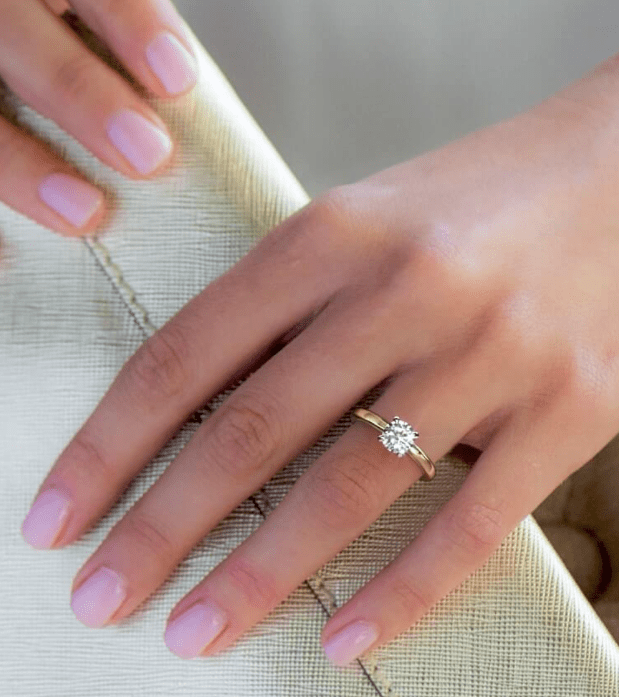
While the second diamond is 3 carat:
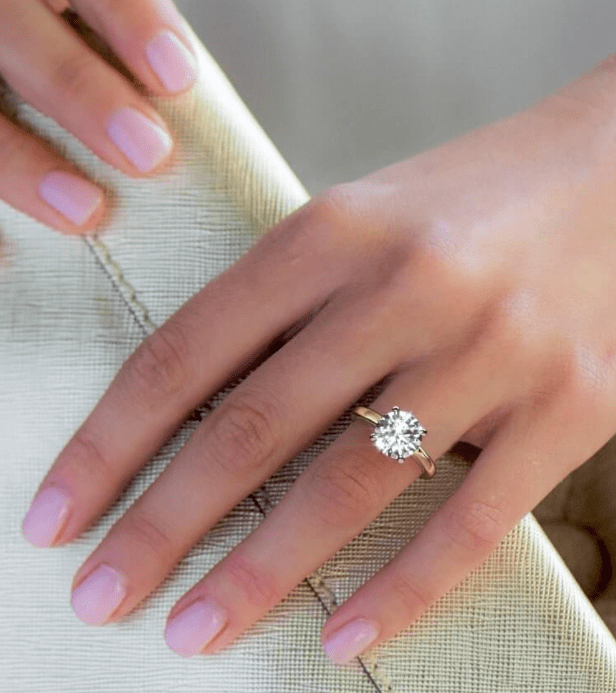
You can clearly see how different diamond carat weights appear when placed on a finger. The 3-carat diamond looks significantly bigger than the 1-carat diamond.
The Effect of Cut on Carat Appearance
The quality of the diamond cut is paramount in determining how large it appears. A diamond with a poor cut may look smaller than a diamond with a better cut. The proportions, symmetry, and polish all play a role in this effect.
The Effect of Cut on Carat Price
Carat weight is more than just a number; it’s a critical factor that affects both the appearance and price of a diamond. Understanding how carat weight influences these aspects can guide you in making an informed decision when purchasing a diamond.
While larger carat weights do often result in a diamond that looks larger, they also come with a higher price tag.
To demonstrate the difference in price, we have included a table that shows the prices of round diamonds with the same characteristics (G colour, VVS1 clarity, and an ideal cut) but different carat weights from the same retailer – Blue Nile.
| Carat weight | Price |
|---|---|
| 0.5 carat | £996 |
| 1 carat | £4,873 |
| 2 carat | £19,499 |
| 3 carat | £51,066 |
As you can see, the larger carat weight a diamond has, the more expensive it will be.
Understanding the “Magic Sizes”
In the world of diamonds, certain carat weights are referred to as “magic sizes” and often carry a significant premium in price. Understanding these magic sizes and how they affect pricing can provide savvy buyers with opportunities to maximise value without sacrificing appearance.
Why Magic Sizes Matter
Magic sizes are specific carat weights that are highly sought after in the market. Magic sizes like 0.50, 1.00, and 1.50 carats are considered benchmarks in the diamond industry and can command premium pricing.
These specific carat weights are often seen as more desirable, leading to a psychological effect where they are perceived as more valuable. This perception can translate into a substantial difference in price compared to diamonds just below these weights.
Tips on Choosing Just Below Magic Sizes
Selecting a diamond just below a magic size can offer significant savings without a noticeable difference in appearance. Here are some practical tips to consider:
- Look for Slightly Lower Carat Weights: Choosing a diamond that’s slightly below a magic size, such as 0.49, 0.99, or 1.49 carats, can save money without sacrificing visual appeal. The difference in size is often negligible to the naked eye.
- Consider Cut and Proportions: A well-cut diamond with proportions that maximise its visual size can appear larger than its actual carat weight. This can allow you to choose a slightly smaller carat weight without losing the desired appearance.
- Consult With a Trusted Jeweller: Working with a knowledgeable and reputable jeweller can help you find diamonds that offer the best value just below the magic sizes. Their expertise can guide you in selecting a diamond that meets your preferences and budget.
The Illusion of Size Тhrough Settings and Shapes
The setting of a diamond plays a crucial role in how its size is perceived. Certain settings can accentuate the diamond’s size, while others may create a more understated effect.
- Settings Тhat Enhance Size: Settings like the halo, which surrounds the diamond with smaller stones, can make the central diamond appear larger. Similarly, prong settings that allow more light to enter the diamond can also enhance its visual size.
- Settings Тhat Minimise Size: Settings like bezel, which encases the diamond’s edge, may create a more contained appearance, potentially making the diamond look smaller.
When selecting a setting, consider the overall design, your personal style, and the diamond’s qualities. Consulting with a skilled jeweller can provide personalised recommendations tailored to your specific diamond and design goals.
The Impact of Cut on Perceived Carat Size
A well-cut diamond can work wonders in maximising visual size. The precision, symmetry, and proportions of the cut can create a play of light that makes the diamond appear larger than its actual carat weight.
A diamond cut with ideal proportions and symmetry can reflect light more effectively, creating brilliance and sparkle that enhance its visual size.
Cut quality is paramount in achieving this effect. A poorly cut diamond may lack the brilliance and appear dull, diminishing its visual impact.
Tips on Prioritising Cut Quality
Prioritising cut quality can be a wise investment in maximising the visual impact of a diamond. Here are some practical tips:
- Look for Certified Diamonds: Choose diamonds that are certified by reputable organisations, like the GIA, which provide detailed information on cut quality.
- Consider the Overall Design: Think about how the cut will interact with the setting and shape to create the desired appearance. A well-chosen cut can elevate the entire piece, making it truly exceptional.
- Consult With an Expert Jeweller: An expert jeweller can guide you in selecting a cut that complements the diamond’s characteristics and your design preferences.
The Influence of Shape and Carat Weight
The shape of a diamond is a defining characteristic that can significantly influence how the carat weight is perceived. Different shapes distribute carat weight differently, affecting the visual size and brilliance of the diamond, and certain carat weights may be more popular with specific shapes.
Round diamonds, the most traditional shape, often appear larger due to their maximum light reflection.
- Shapes That Enhance Size: Shapes like oval, marquise, and pear often appear larger for their carat weight due to their elongated proportions.
- Shapes That Minimise Size: Shapes like Asscher and radiant may appear more contained and thus look smaller for their carat weight.
When selecting a diamond shape, consider your desired style, finger shape, and overall aesthetics. Understanding how different shapes interact with light and proportions can guide you in choosing a shape that complements your design vision.
Popular Carat Weights for Different Shapes
Popular carat weights can vary significantly depending on the diamond shape.
- For round diamonds, the most popular carat weights are often those that hit “magic sizes”, such as 0.5, 1, or 1.5 carats. These sizes are particularly sought after due to their significant visual impact and psychological appeal.
- For fancy shapes, like oval, pear, or marquise, popular carat weights might be slightly different, such as 0.7, 1.2, or 1.7 carats, as these shapes can appear larger for their carat weight due to their elongated form.
- Princess cut diamonds, with their square shape, often look great in 0.5, 1, or 1.5 carat weights.
Ultimately, the popular carat weight for a specific diamond shape depends on personal preference, budget, and the desired overall look of the piece of jewellery.
Lab-Grown vs. Natural Diamonds: A Carat Comparison
The emergence of lab-grown diamonds has added a new dimension to the world of gemology. These scientifically crafted gems offer an alternative to natural diamonds, with unique characteristics and appeal.
Lab-grown diamonds are created through sophisticated processes that replicate the natural conditions under which diamonds form. They are created in controlled environments using methods like High Pressure High Temperature (HPHT) or Chemical Vapor Deposition (CVD). Even though lab-grown diamonds possess the same physical and chemical properties as natural diamonds, theyare often more accessible in terms of price.
Comparing Carat Weight in Lab-Grown and Natural Diamonds
Carat weight is a critical factor in both lab-grown and natural diamonds. Understanding how carat weight translates into appearance, price, and quality in these two categories can guide informed buying decisions.
- Comparison of Appearance: Lab-grown and natural diamonds can be virtually indistinguishable in appearance at the same carat weight. The choice between them may come down to personal preferences, ethical considerations, or budget constraints.
- Comparison of Price: Lab-grown diamonds often offer a more affordable option at the same carat weight. The savings can be significant, especially for higher carat weights, without compromising on beauty or brilliance.
To show the significant difference in price between natural and lab-grown diamonds, let’s compare two round 1-carat, E-coloured diamonds with VS1 clarity.
One of the diamonds is natural and is priced at £4,640:
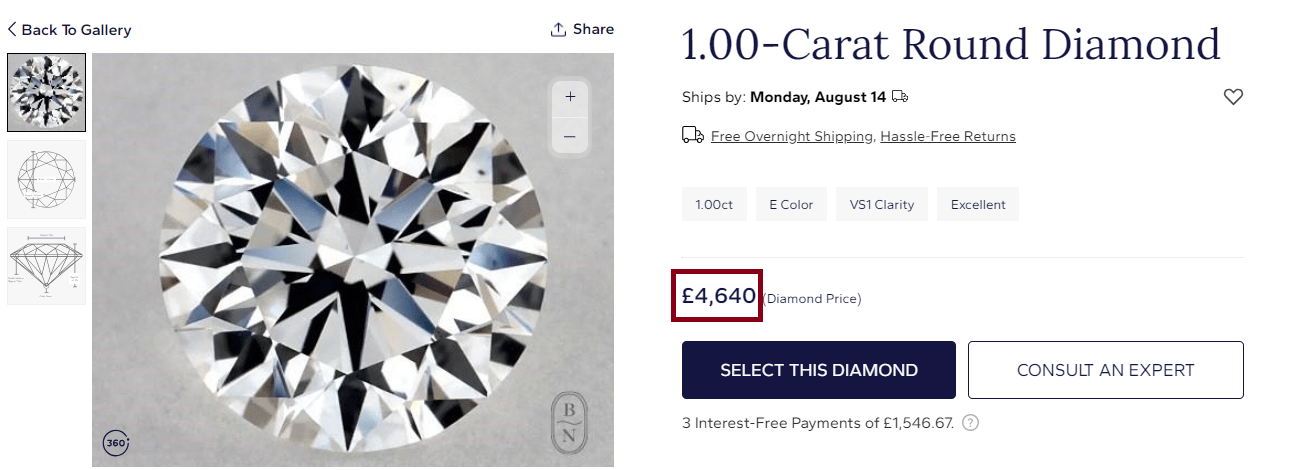
While the other diamond is lab-grown and priced at £1,337:
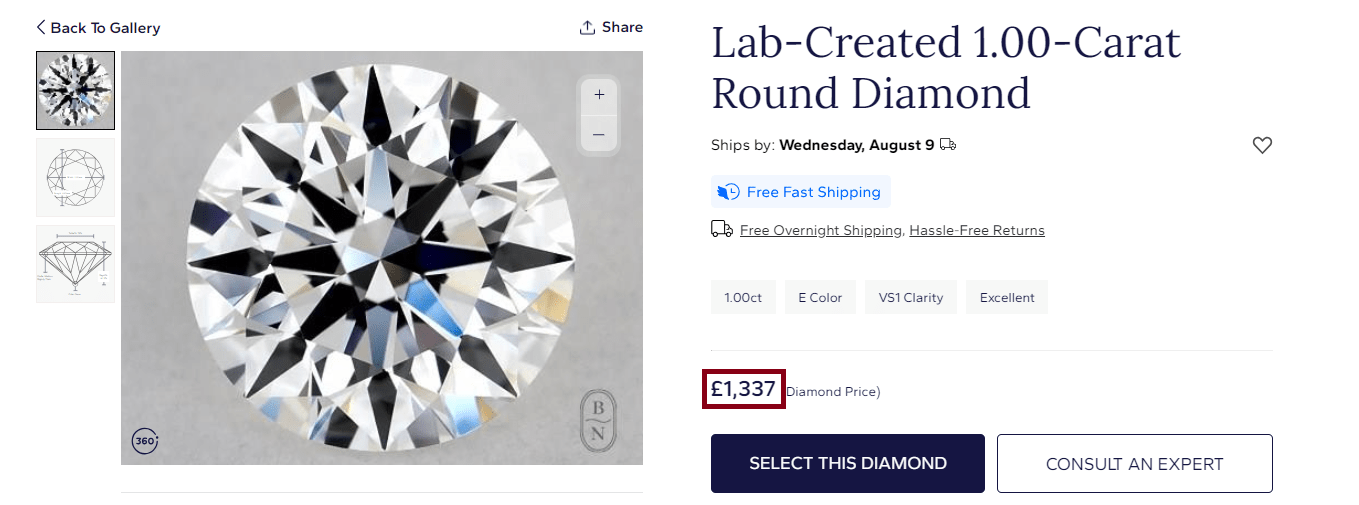
As you can see, the overall difference in pricing comes to over £3,000.
Despite this difference in price, the two diamonds would be indistinguishable from each other.
Quality considerations, such as cut, clarity, and colour, apply to both lab-grown and natural diamonds. Buyers should evaluate these factors in conjunction with carat weight to find the perfect balance that aligns with their desires and budget.
Choosing the Right Carat Weight for Your Diamond
Selecting the right carat weight for a diamond is a nuanced decision that involves balancing various factors, such as budget, style, setting, and personal preferences.
- Budget Considerations: Carat weight significantly influences the price of a diamond. Understanding your budget and how it aligns with different carat weights is essential in making an informed decision.
- Style and Setting Considerations: The style and setting of the jewellery piece can affect how the carat weight is perceived. A particular carat weight may look different in various settings, so considering the overall design is crucial.
Tips for Maximising Value in Carat Selection
Selecting the right carat weight is also about maximising value. Here are some tips to guide you in making a choice that offers the best value for your investment.Consider Cut and Quality: Sometimes, a slightly smaller carat weight with a superior cut and quality can offer more brilliance and visual appeal than a larger carat weight of lesser quality.
- Explore Magic Sizes: As discussed earlier, choosing just below magic sizes can provide savings without a noticeable difference in appearance.
- Think About the Overall Design: Consider how the carat weight will interact with the setting, shape, and overall design to create a cohesive and beautiful piece.
Conclusion: Finding the Perfect Carat Weight for Your Engagement Ring
Understanding carat weight is not just about size; it’s about comprehending how carat weight interacts with other factors to create a diamond’s unique appeal.
- Carat weight is one of the 4Cs that define a diamond’s quality and value. It plays a vital role in determining the appearance, price, and overall allure of the diamond.
- Diamond carat refers to the weight of a diamond, not its size.
- One carat equals approximately 200 milligrams.
Actionable Tips for Purchasing a Diamond
Finding the perfect carat weight for your engagement ring is a rewarding journey that reflects your love and commitment. Here are some final tips and guidance to assist you in this beautiful endeavour.
- Consider the Overall Design: Think about how the carat weight will align with the shape, setting, and style of the ring.
- Balance Quality and Budget: Explore options that offer the best value, considering factors like cut, clarity, and colour, along with carat weight.
- Seek Professional Guidance: Consult with experienced jewellers or gemologists who can provide personalised insights and assistance.
We encourage you to do your own research and get informed before making a purchase.
